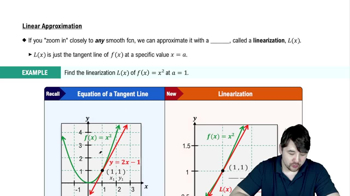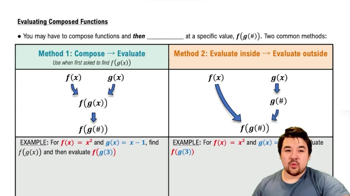Table of contents
- 0. Functions7h 52m
- Introduction to Functions16m
- Piecewise Functions10m
- Properties of Functions9m
- Common Functions1h 8m
- Transformations5m
- Combining Functions27m
- Exponent rules32m
- Exponential Functions28m
- Logarithmic Functions24m
- Properties of Logarithms34m
- Exponential & Logarithmic Equations35m
- Introduction to Trigonometric Functions38m
- Graphs of Trigonometric Functions44m
- Trigonometric Identities47m
- Inverse Trigonometric Functions48m
- 1. Limits and Continuity2h 2m
- 2. Intro to Derivatives1h 33m
- 3. Techniques of Differentiation3h 18m
- 4. Applications of Derivatives2h 38m
- 5. Graphical Applications of Derivatives6h 2m
- 6. Derivatives of Inverse, Exponential, & Logarithmic Functions2h 37m
- 7. Antiderivatives & Indefinite Integrals1h 26m
- 8. Definite Integrals4h 44m
- 9. Graphical Applications of Integrals2h 27m
- 10. Physics Applications of Integrals 2h 22m
4. Applications of Derivatives
Linearization
Problem 4.6.19
Textbook Question
Linear approximation Find the linear approximation to the following functions at the given point a.
f(x) = 4x² + x; a = 1
 Verified step by step guidance
Verified step by step guidance1
Identify the function f(x) = 4x² + x and the point a = 1 where we need to find the linear approximation.
Recall the formula for the linear approximation of a function at a point a, which is L(x) = f(a) + f'(a)(x - a).
Calculate f(a) by substituting x = 1 into the function: f(1) = 4(1)² + 1.
Find the derivative of the function, f'(x). For f(x) = 4x² + x, use the power rule to get f'(x) = 8x + 1.
Evaluate the derivative at the point a: f'(1) = 8(1) + 1. Substitute f(a) and f'(a) into the linear approximation formula to get L(x) = f(1) + f'(1)(x - 1).
 Verified video answer for a similar problem:
Verified video answer for a similar problem:This video solution was recommended by our tutors as helpful for the problem above
Video duration:
4mPlay a video:
Was this helpful?
Key Concepts
Here are the essential concepts you must grasp in order to answer the question correctly.
Linear Approximation
Linear approximation is a method used to estimate the value of a function near a given point using the tangent line at that point. It is based on the idea that a function can be closely approximated by a linear function when evaluated near a specific value. The formula for linear approximation is f(a) + f'(a)(x - a), where f'(a) is the derivative of the function at point a.
Recommended video:

Linearization
Derivative
The derivative of a function at a point measures the rate at which the function's value changes as its input changes. It is defined as the limit of the average rate of change of the function as the interval approaches zero. In the context of linear approximation, the derivative at point a provides the slope of the tangent line, which is crucial for constructing the linear approximation.
Recommended video:

Derivatives
Function Evaluation
Function evaluation involves calculating the output of a function for a specific input value. In the context of linear approximation, it is essential to evaluate both the function f(x) and its derivative f'(x) at the point a. This allows us to determine the function's value and the slope of the tangent line, which are necessary components for creating the linear approximation.
Recommended video:

Evaluating Composed Functions
Related Videos
Related Practice



